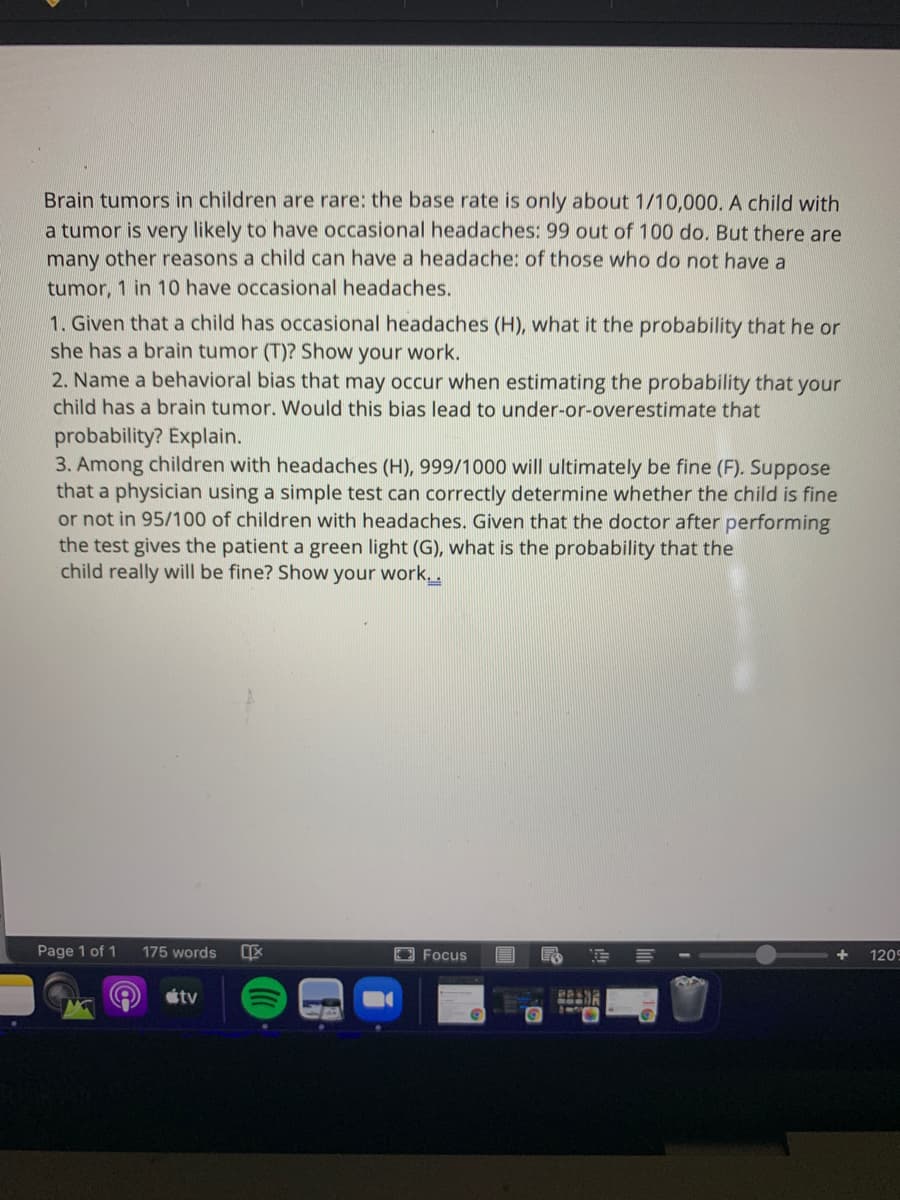Brain tumors in children are rare: the base rate is only about 1/10,000. A child with a tumor is very likely to have occasional headaches: 99 out of 100 do. But there are many other reasons a child can have a headache: of those who do not have a tumor, 1 in 10 have occasional headaches. 1. Given that a child has occasional headaches (H), what it the probability that he or she has a brain tumor (T)? Show your work. 2. Name a behavioral bias that may occur when estimating the probability that your child has a brain tumor. Would this bias lead to under-or-overestimate that probability? Explain. 3. Among children with headaches (H), 999/1000 will ultimately be fine (F). Suppose that a physician using a simple test can correctly determine whether the child is fine or not in 95/100 of children with headaches. Given that the doctor after performing the test gives the patient a green light (G), what is the probability that the child really will be fine? Show your work.,.
Brain tumors in children are rare: the base rate is only about 1/10,000. A child with a tumor is very likely to have occasional headaches: 99 out of 100 do. But there are many other reasons a child can have a headache: of those who do not have a tumor, 1 in 10 have occasional headaches. 1. Given that a child has occasional headaches (H), what it the probability that he or she has a brain tumor (T)? Show your work. 2. Name a behavioral bias that may occur when estimating the probability that your child has a brain tumor. Would this bias lead to under-or-overestimate that probability? Explain. 3. Among children with headaches (H), 999/1000 will ultimately be fine (F). Suppose that a physician using a simple test can correctly determine whether the child is fine or not in 95/100 of children with headaches. Given that the doctor after performing the test gives the patient a green light (G), what is the probability that the child really will be fine? Show your work.,.
Chapter2: Mathematics For Microeconomics
Section: Chapter Questions
Problem 2.15P
Related questions
Question

Transcribed Image Text:Brain tumors in children are rare: the base rate is only about 1/10,000. A child with
a tumor is very likely to have occasional headaches: 99 out of 100 do. But there are
many other reasons a child can have a headache: of those who do not have a
tumor, 1 in 10 have occasional headaches.
1. Given that a child has occasional headaches (H), what it the probability that he or
she has a brain tumor (T)? Show your work.
2. Name a behavioral bias that may occur when estimating the probability that your
child has a brain tumor. Would this bias lead to under-or-overestimate that
probability? Explain.
3. Among children with headaches (H), 999/1000 will ultimately be fine (F). Suppose
that a physician using a simple test can correctly determine whether the child is fine
or not in 95/100 of children with headaches. Given that the doctor after performing
the test gives the patient a green light (G), what is the probability that the
child really will be fine? Show your work..
Page 1 of 1
175 words
EFocus
1209
étv
Expert Solution
This question has been solved!
Explore an expertly crafted, step-by-step solution for a thorough understanding of key concepts.
This is a popular solution!
Trending now
This is a popular solution!
Step by step
Solved in 2 steps

Recommended textbooks for you

